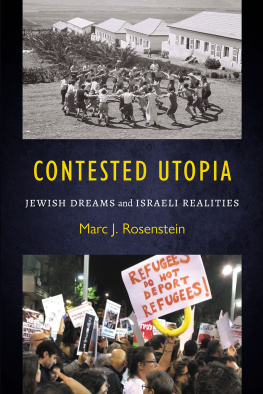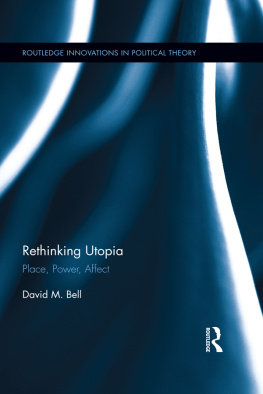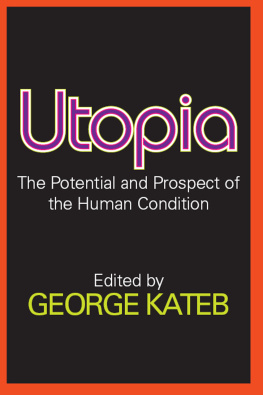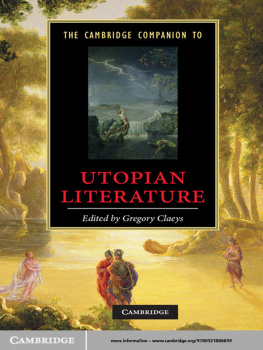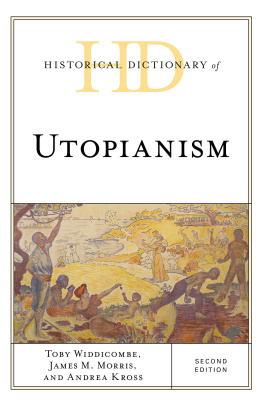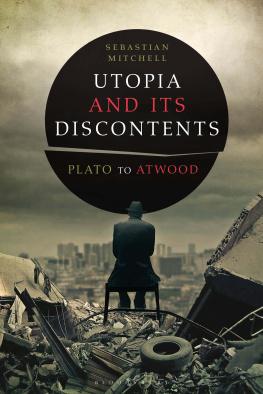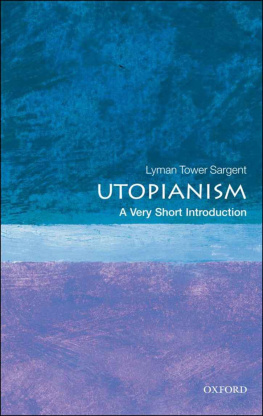LIVING IN UTOPIA
To our families:
Evan, Jennifer, Ivan and Kieran
Debbie, Marc, Kerry, Hilary, Mike, Jackie and Conrad
First published 2004 by Ashgate Publishing
Published 2016 by Routledge
2 Park Square, Milton Park, Abingdon, Oxon OX14 4RN
711 Third Avenue, New York, NY 10017, USA
Routledge is an imprint of the Taylor & Francis Group, an informa business
Copyright 2004 Lucy Sargisson and Lyman Tower Sargent
Lucy Sargisson and Lyman Tower Sargent have asserted their right under the Copyright, Designs and Patents Act, 1988, to be identified as the authors of this work.
All rights reserved. No part of this book may be reprinted or reproduced or utilised in any form or by any electronic, mechanical, or other means, now known or hereafter invented, including photocopying and recording, or in any information storage or retrieval s ystem, without permission in writing from the publishers.
Notice:
Product or corporate names may be trademarks or registered trademarks, and are used only for identification and explanation without intent to infringe.
British Library Cataloguing in Publication Data
Sargisson, Lucy. 1964
Living in Utopia: New Zealands intentional communities
1.Communal living - New Zealand 2.Communal living 3. Utopias
- New Zealand History
I.Title 11.Sargent. Lyman Tower
307.7'7'993
Library of Congress Cataioging-in-Puhlication Data
Sargisson, Lucy, 1964
Living in utopia: New Zealands intentional communilies / by Lucy Sargisson and Lyman Tower Sargent.
p. cm.
Includes bibliographical references and index.
ISBN 0-7546-4224-0
1. Collective settlements-New Zealand. 2. Collective settlements. 3. I Hopias-New ZealandHistory. I. Sargent, Lyman Tower, 1940- II. lille.
HX780.4.A3S27 2004
307.770993-de22
2004009638
ISBN 9780754642244 (hbk)
Contents
Lyman Tower Sargent undertook the initial work of compiling the first list of intentional communities in New Zealand during 199596, and he wishes to thank those who made that year of research possible the College of Arts and Sciences of the University of Missouri-St Louis and the Stout Research Centre for the Study of New Zealand Society History and Culture, Victoria University of Wellington. Those who have helped him specifically with his research on New Zealand intentional communities include the staffs of the Alexander Turnbull Library, the National Library of New Zealand Te Puna Matauranga O Aotearoa, and the Hocken Library, Dunedin. Individuals at other libraries who provided information include Fiona Corcoran of the Hamilton Public Library, Lynley Fowler of the Wanganui District Library, Mrs Tiena Jordan of the Whakatane District Museum and Gallery, Heather Knowles of the Macmillan Brown Room at the University of Canterbury Library, Mrs Gale Lockwood of the Waihi Arts Centre and Museum, Ann Milton-Tee of the Gisborne Museum and Arts Centre, Eris Parker of the Cambridge Museum, Mrs Jinty Rorke of the Tauranga Museum, Elizabeth Sharpe of the Whanganui Regional Museum, Stephanie van Gaalen of the Nelson Provincial Museum and David Verran of the Auckland Research Centre of the Auckland City Libraries. Individuals who assisted with advice, information, and less tangible forms of support include Ian Burn, Peter Callister, Michael Crawshaw, Raewyn Dalziel, Brian Easton, Miles Fairburn, Maurice Goldsmith, Margaret Hayward, Jonathan Hunt, Murray S. Martin, Elizabeth McLeay, Julienne Molineaux, Arnold Parr, John Pocock, Frank Rogers, Andrew Sharp, James Traue, Christina Tuitubou, Carole Van Grondelle, Lydia Wevers, Gareth Winter and Dianne Yates. He would also like to thank the members of Chippenham and Creekside for allowing him to visit them and Keith Langford of the Timatanga Community for providing him with information on the community as it then existed.
The following individuals provided particular assistance in the second stage of his research in 2000 Margareta Gee and other staff members of the Alexander Turnbull Library, the staff of the Beaglehole Room of Victoria University Library, Nigel Roberts for his memories of the early years of Creekside, Hilary Stace for sharing her research on The School of Radiant Living and the Department of Politics at Victoria University for providing an appointment that allowed the research to go ahead.
Lucy Sargissons pilot study in 2000 was funded by a grant from the University of Nottinghams Research Committee and a Personal Research Fund from the School of Politics at Nottingham University. Her fieldwork in 2001 was co-funded by a Personal Research Grant from the British Academy (Award No:SG3144) and a Personal Research Grant from the University of Nottingham. Thanks to Bill Metcalf for providing documents and to members of the Society for Utopian Studies for comments on drafts.
She thanks all those people across New Zealand who allowed her to visit and stay in their homes, and to join, for a time, in their lives. These people are too numerous to mention by name but especial thanks go to Dave Welch of Chippenham. The pilot study would have been impossible without the help of the Ward family (Philip, Clare, Anthea, Theodora, Marcus and Ann) and Colleen Tiller. Thanks to Clare Giffard, Marie Beech, Clare and Philip Ward, and Pam and David Giffard for putting her up. Many people provided help, from loans or gifts of useful things (Maurice Goldsmith and Elizabeth McLaey, and Phil), to time (Paki Harrison, Cam and Margaret Hunter, Barry Brickell, Heath Black, Jeanette Fitzsimons, Cyril Ngamane), to friendship (Robina McCurdy, Udaya).
Thanks are also due to students and colleagues at the School of Politics at Nottingham University, Sarah Nolan for her patience in transcription, Colin Rowan, friends too numerous to list, her family and lastly to Chris Pierson, for his powers of endurance.
Utopia is the good place that is no place. Utopian imaginings of a better world exist, for the most part, in the world of fiction or theory. Examples include Thomas Mores Utopia (1516), B.F. Skinners Walden Two (1948) and, more recently, David Harveys Spaces of Hope (2000). What happens then, when we try to realise utopia? What happens when we try to realise our dreams for a better world, a better way of being? Some imagine that dystopia will result and that the world will resemble a fiction such as George Orwells Nineteen Eighty Four (1949) or, more recently, Margaret Atwoods Oryx and Crake (2003). This book seeks to explore utopian phenomena that are not constrained to the world of fiction and that exist in the world here and now. These are intentional communities. We are concerned to learn about peoples experiments with their daily lives through the creation of communities that aim to realise a desire for a better way of living.
Four countries have temporarily had policies supporting the development of intentional communities, previously known, among other things, as utopian experiments and communes. Two, Australia and Israel, developed their policies as aspects of settlement and nation building; one, the United States, developed one in direct response to economic depression; and one, New Zealand, developed one because it might help channel the energies of disaffected youth. The issue that inspired New Zealand is significantly different from those that inspired the other countries, and the choice of a solution that is often connected with utopianism, illustrates the central role that utopianism played in New Zealand history. The New Zealand experiment, the Ohu Movement discussed in , while inspiring hundreds if not thousands of young New Zealanders, was an almost complete failure. The Murray River Settlements in Australia and the New Deal Resettlement Colonies in the United States were partial successes. The Kibbutz Movement in Israel, an inspiration of the Ohu Movement, is, of course, on going, although currently troubled.



